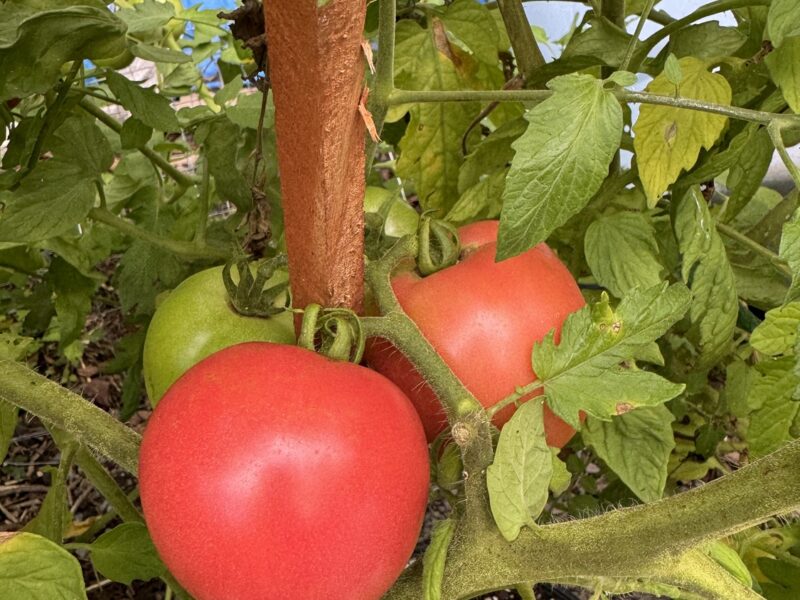

Last April, I set up a small growing operation in my office that would allow me to grow some plants from seeds for later outdoor planting. I bought an LED grow light, a heating pad, a timer and various-sized cell packs and peat pots for the venture. It ended up turning into a tomato experiment, and I wanted to share the results with you. But first, some disclaimers.
Every year I grow just a few vegetables as my garden space is pretty much set aside for my perennials — thousands of them. And despite my mantra that there is always room for one more plant in the gardens, that does not include vegetables. I’ve grown a tomato or two in my 900-square-foot trial garden, but again, space in there is always at a premium and pretty much dedicated to perennials as well.
Yes, there’s been the occasional broccoli, maybe a tomato or two, and this year a few cabbages I want to try, but nothing at all on a grand vegetable scale. But I had seeds from three tomatoes of three types that I wanted to try. Oh, for just one great tasting tomato. Did it work? Did my gustatory fantasy get satisfied? Read on.
I’m a great planner and usually very well organized, but this time I was winging it. Step one was to sow the seeds and two seeds of each of the three varieties were sown in each of about 18 peat pots. I had the requisite bottom heat (72 degrees) and the light was being provided by my new LED grow light strips but it would be a week or more after sowing the seeds before the lights would come into play. Two seeds were sown in each pot under the theory that if both germinated one would be left to mature, the other simply cut at the soil surface.
The three varieties I worked with were: Strawberry Fields, noted as a “pink slicer” with blight resistance and an indeterminate type — but I forgot that part. The flavor was said to be “wonderfully balanced-sweet and acidic with a juicy texture,” bearing fruits of 7 to 10 ounces. Second was Candy Bell, a determinate grape type. A determinate grape is very unusual. It was noted that no pruning was required, a big plus.
The third variety was Norfolk Healthy Produce’s “The Purple Tomato.” I chose this one due to its color, which had the promise of higher antioxidants, notable taste and a different color for a tomato — purple. Mine, however, were more on brown than purple, but no big thing.
All the plants grew well under the LED grow lights, but there was a learning curve there too as the lights had no instructions. I opted for 12 hours of the lights on and 12 off. In about five weeks under the lights all the plants were of sufficient size to get hardened off so they went on my back porch for several days where there’s only morning sun and little wind. Then they went to a spot where they received full sun and I began a fertilizer regimen. More on fertilizer shortly.
Now what? I had a large group of tomato plants and no place to plant them. Twelve of the plants were distributed to neighbors for their gardens but where oh where would I plant mine? I did have a very sunny and warm spot in the parking area of our crushed stone (aka item #4) driveway, and that would mean growing each plant in its own pot. I’ve always got a supply of large, black nursery pots and a bale of Pro-Mix so that was my solution. Each plant got its own pot with each pot being about 15 inches in diameter and 18 inches tall. An inch of space was left at the top of each pot for water collection, and an initial 2-foot-tall stake to stabilize each plant was pushed into the soil next to the stem. The six pots were set in a line, north to south, watered well and I was all set — for now.
I was able to water the plants either from a nearby hose or using a watering can, and as the days warmed the plants took off. But since I was growing the plants in a nearly sterile peat-lite mix (Pro-Mix) I would need to add fertilizer regularly to my watering routine. Using the watering can, I would add half the label rate of liquid organic fertilizer. Every four to six days, instead of a straight watering, the plants would be given fertilizer-infused water. That seemed to work very well, and for the entire growing season the plants showed no signs of nutritional stress —or did they? No, no visible signs.
As the plants grew and grew I realized I’d made a major mistake. There was no trellis or staking to hold the plants up. Being the creative sort, I drove three 10-foot stakes into the driveway at either end of the line of pots. The stakes were now 8 feet tall and driven 2 feet in the ground. I then cut some lumber into vertical supports and wired them to the horizontal supports 4 feet above the driveway. This seemed to work, and during the summer I pruned and manipulated the vines to grow north and south, removing the suckers that wanted to grow toward the arch of the sun, west. Garden twine and stretchable vinyl garden tape bound or tied the stems to the trellising.
Now, only one of the three varieties was determinate and well behaved. The semi-determinate grape-type was manageable. The indeterminate Strawberry Fields, on the other hand, was a bit of a mistake for this kind of limited setup, and it sent some of its vines down the hill in back and into a garden bed on the north end. The chipmunks were very appreciative as these rampant vines began to produce fruit.
At the end of the summer, when I sat to consider what had gone right and wrong with this project, I realized that there hadn’t been a single issue with insects or disease. How could this be? First and foremost, the plants were being grown above ground, out of native soils where disease pathogens might be lurking. There was also no splashing water, other than from some occasional showers, and the lack of water on the tomato foliage pretty much squashed any chances of diseases on droplets of water or splashing from the surrounding ground. There was only crushed stone.
One concern during the summer was that the black plastic pots were absorbing a great deal of heat as the sun beat down on them and this resulted in the pots drying out quickly. My solution was in the form of some concrete boards that we’d used on the exterior of my office. They were white, about a foot tall and 8 feet long. I simply set them in front of the pots, leaning against the pots, and they became the perfect sun shields.
As for insects, there was no tomato hornworm and not a single aphid. Again, because the plants were not at ground level and because tomatoes had never been grown nearby before. My big surprise and delight was that there were no whiteflies. So, in the insect and pathogen departments, this was a great success.
The plants all set flowers and fruit in abundance. The vines were productive for weeks and weeks even from Candy Bell which, as a determinate type, should have stopped producing but remained quite prolific yet manageable.
In all, a full summer of tomatoes from late July through early fall. Strawberry Fields and Candy Bell were as productive as promised, with Candy Bell producing clusters of tomatoes just like you see on the fanned branching stems in the market. The Purple Tomato was a bit of a learning curve due to its color change as it matures. Left on the vine too long the fruits seemed to blister a bit, and as per the developer of the variety, the taste changes as the color deepens. And yet, none of the color clues led to great-tasting fruit, just OK at best. Strawberry Fields was firm and a great slicer, but I was hoping for a more definitive taste. Instead, the fruits were often borderline bland.
At the end of the season I needed to get the pots out of the parking area and the soil and plants to the compost pile. As I attempted to lift each pot off the stone parking area I was amazed to find that each plant had sent a mighty root down through the center drainage hole and deep into the driveway. It was then that I remembered pulling a tomato plant out of the ground in the trial garden several years ago and being amazed at the massive root system (deep and wide) that it had developed.
I love to experiment, learn from my experiences and this certainly was an interesting one. My long-standing complaint (and a fairly common one repeated by gardeners and acknowledged by the seed companies) is the lack of the great taste that we remember from years ago. Did all three varieties lose their heritage tomato taste due to breeding or was it growing these three varieties in “artificial” soil or improper nutrients?
In all, this little experiment showed that if you’ve got plenty of sun you can grow tomatoes in large pots just about anywhere. But there was still the taste issue, or better said, lack of taste issue. Was this related to the growing regime, or have breeders simply lost that taste that many of us seem to remember and lust for? Let me know what you think and of course, keep growing.
 More Posts from Andrew Messinger
More Posts from Andrew Messinger